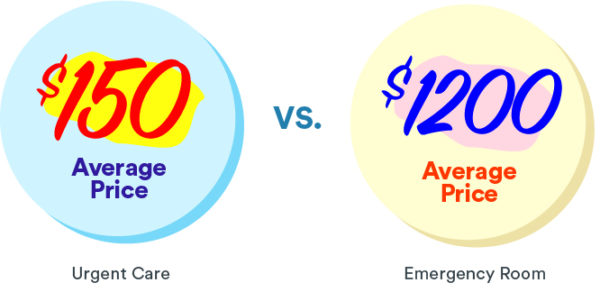This post has been sponsored and guest written by SOLV to bring you this informative post for parents!
It can be terrifying when your child gets sick enough to warrant an immediate trip to the doctor. If your regular pediatrician isn’t available, your next thought may be to go straight to the emergency room. That’s an understandable reaction. You just want them to get treated quickly so they can feel better as soon as possible.
However, there are many circumstances when urgent care may actually be the best place to take your child when they’re sick.
“Wait Time” Matters

What a lot of parents don’t often realize, is you’ll be seen faster at an Urgent Care. The average waiting time at the ER is three hours!! That’s excruciating and exhausting, especially when your son or daughter is really upset. At urgent care facilities, on the other hand, the average wait time is just 30-40 minutes. And, there are now online sites like Solv that help you find an urgent care visit without a wait, and book an appointment with just a few taps.

A Less Stressful Environment
Secondly, an ER can be a pretty scary place for children. From the waiting room area to all the medical machinery to being in such close proximity to other patients (many with very serious conditions), it can be traumatizing. Urgent care facilities tend to be a much more pleasant experience. The waiting rooms are calmer, the treatment rooms are more private, and the doctors are generally less rushed.
Comparing Cost

Most importantly, the cost of a visit to the emergency room will be far higher (on average) than an Urgent Care. It can be astronomical, even for minor conditions. According to PLOS One, a peer-reviewed scientific journal, the median bill for an ER visit is a whopping $1200. At urgent care, the average bill is just $150. That’s a significant out-of-pocket savings, especially if you have a high-deductible insurance plan.
“I always tell parents, do you want an $800 earache or a $100 earache for the same level of care?” says Gerlacher, M.D. and CEO of Pediatric Urgent Care Consultants (he’s also worked in ER facilities).
Of course, if you think your child is experiencing something life-threatening, the ER is the best place to go. That’s primarily because they have the equipment necessary to treat more serious medical issues.
“As a general rule,” says Gerlacher, “we tell people that anything that can be life threatening—like significant blood loss, severe difficulty breathing, or altered mental status—you should go to ER.”
But there are many less-severe, acute ailments that can be treated just as well at an urgent care facility as at the ER (without the wait time and high out-of-pocket costs). Gerlacher even argues that in some cases, urgent care doctors are better suited to identify and then treat these types of things because they do it day in and day out. Urgent care practitioners can quickly administer IV fluids, do basic laceration repair, X-rays, splinting, and asthma care. And for kids with a nasty sore throat, a rapid strep test at urgent care takes just minutes. The same test would take an hour at the ER.
For children experiencing the following symptoms, Gerlacher says urgent care may make more sense:
- Ear pain
- Sore Throat
- Flu & Cold Symptoms
- Coughs
- Fever without Rash
- High Fevers
- Diarrhea
- Vomiting
- Cuts & Scrapes
- Broken Bones
- Painful Urination
- Minor Injuries & Burns
 As a worried parent, we know it’s your top priority to get the best treatment. That’s why when your child has certain symptoms, urgent care is often the best option to get them happy and healthy quickly. Then they can get back to the playground.
As a worried parent, we know it’s your top priority to get the best treatment. That’s why when your child has certain symptoms, urgent care is often the best option to get them happy and healthy quickly. Then they can get back to the playground.
Solv, a mobile app, is helping DFW patients simplify everyday healthcare by helping you find and book a last minute doctor’s appointment with a reputable doctor at a time and place that is convenient for you.
Using a smartphone’s GPS, Solv determines the user’s location, and its algorithm matches patients to the right clinics based on chief complaint, insurance coverage and appointment availability. Solv also streamlines insurance by allowing patients to use their phone’s camera to take a picture of their insurance card, and get a translation of their family insurance benefits. Solv is currently servicing the DFW area..
For more information on Solv, visit their website or social media channels for details!














I feel like this article is a bit misleading because, turns out, it’s nothing more than an advertisement for Solv? Urgent care facilities can, in fact, cost much more than what is averaged in this article. I was expecting to read an article from an actual mom about her experiences and/or research regarding urgent care vs. the ER…not an article sponsored by an app.
Hi Wendy! thanks for your message! To clarify, Solv Heath, a digital app, did help put this article (which is stated on the featured graphic and disclosure at the top of the post). They provided the resources and data for all for all of the information to make this post credible. I do think there is a difference in “urgent care” and the pop-up ER’s that are showing up all over town. You’re correct in that those CAN cost much more than an “in-patient” emergency room, especially if you’re seen by a facility that won’t accept your insurance.
Of course, it’s always helpful to know in advance which places will accept your insurance plans so when an emergency does arise, this information provided in the post can be more helpful.
As I was reading your article, you state that wait time matters and a lot of parent’s don’t realize that you can be seen faster in an urgent care clinic than in the ER. My daughter hasn’t been sick enough for us to take this type of action, but it is excellent information to have for the future. Thank you for writing such an informative article about making the right choice for an urgent care clinic vs. an ER.